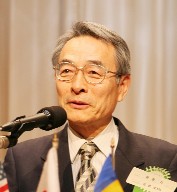��Health and Nutrition (Overcoming Metabolic Syndrome)��
January 23, 2008
Mr. Shaw Watanabe,
Director-general, National Institute of Health & Nutrition,
 Control diabetes with diet and exercise
Control diabetes with diet and exercise
��When I was 50 years old I weighed 77 kg. I contracted diabetes at the age of 53. At that time, I had been prolifically occupied as the head of epidemiology at the National Cancer Center.
��When I weighed myself in the hotel in Kyoto where I stayed for a business trip, I discovered I lost 4 ��5kg. I suspected pancreatic cancer and the data from an examination after my return to Tokyo showed blood sugar count of 260 mg/dl, hemoglobin Alc value of 12.8%, blood pressure of 155/90 mmHg, and triglyceride of 250 g/dl. Ultra-sound examination showed a typical fatty liver.
��I was told that I needed to be hospitalized and treated with insulin but I selfishly responded that I wanted to see how much I can cure by simple diet and exercise and I began my battle against diabetes. I executed a regular life taking 3 meals a day at regular times and after work I go swimming at a nearby pool every day for 30 minutes to an hour and in bed sleeping by 9 o��clock.
After 1 year my weight was 60 kg and all of my subjective symptoms had disappeared and blood sugar count was at 100 mg/dl, hemoglobin Alc of 5.7%, blood pressure of 130/80 mmHg and neutral fat of 150 mg/dl. I maintained a daily caloric intake of 1,600 kilo calories. After physically becoming aware of the direct impact of diet on the body, I transferred to Tokyo University of Agriculture to undertake research in nutritional science.
��I am currently 67 and weigh 60 kg and maintain a blood sugar count of 150 mg/dl, hemoglobin Alc value of 7.0%, blood pressure of 117/75 mmHg and neutral fats of 100 mg/dl.
Since 2 years ago I have been researching what and how much can be controlled by diet and exercise at an independent administrative institution of the Ministry of Health, Labour and Welfare. This is the Saku Control Obesity Program (SCOP). This is a program in which 235 patients who had BMI (value derived by dividing the weight by a square of height, and value of 25 or higher considered to be obese) of 30 or higher were chosen from among 50,000 recipients of comprehensive medical examinations and the relationship between weight and blood pressure was examined using life styles and diet during the period from July of 2006 and July of 2009.
��At this point and time, according to the change in blood pressure data according to the degree of weight loss, those who had experienced 10 kg or more in weight loss also had reduced their blood pressure by 20. Surprisingly, even those who did not lose weight, but developed an exercise regimen, experienced a decline in blood pressure. What effects does a reduction in blood pressure by 10 bring about? From epidemiological studies, there are statistics that indicate if blood pressure of the entire population declined 2 mm, cases of cardiac infarctions would decline by 6%, chronic heart disease would be reduced by 4% and overall cardiovascular diseases would be reduced by 3%. Assuming there are 10 million cardiac circulation-related patients, there would be a reduction by 300,000 of such patients. If blood pressure is reduced by 5 mm, it is estimated that cardiac infarctions would decline by 14%, chronic cardiac diseases would decline 9% and, in total, cardiovascular diseases would decline by 7%. I think you would appreciate the efficiency of preventive medicine.
The National Institute of Health & Nutrition pioneering in proposing measures
In ��Health Japan 21��, a variety of epidemiological measures is discussed. Among these, measures against obesity are important. Over a half of middle-aged men are obese. 1 kilogram of fat equals 7,000 kilo calories. If this is divided by 30, it would be 240 kcal. In other words, if one walks 30 minutes a day and reduce intake of rice by 1 bowl, one should be able to constantly shed 1 kilogram each month. One needs to be aware of the calories needed and get into the practice of consuming the needed calories. Both the producers and providers together need to reinforce their awareness of calorie labeling.
The National Institute of Health & Nutrition is collecting variety of evidence with a view for the future
1.Knowledgeable Food Circle: a full course meal with 360 kcal
2.Circle to spread low protein diet: 0.5g/weight in kg / day
3.Food Nursing Research Group: Creating standards for difficult to swallow foods
4.Food Labeling Research Circle: Cautionary labeling of all foods
These are some of the major activities being undertaken.
What is needed now is to look to the future 30 to 50 years ahead. The Institute has served the population for over 85 years. It will continue to make policy recommendation that looks to the future as a research and development-oriented independent administrative institution and would appreciate your support.